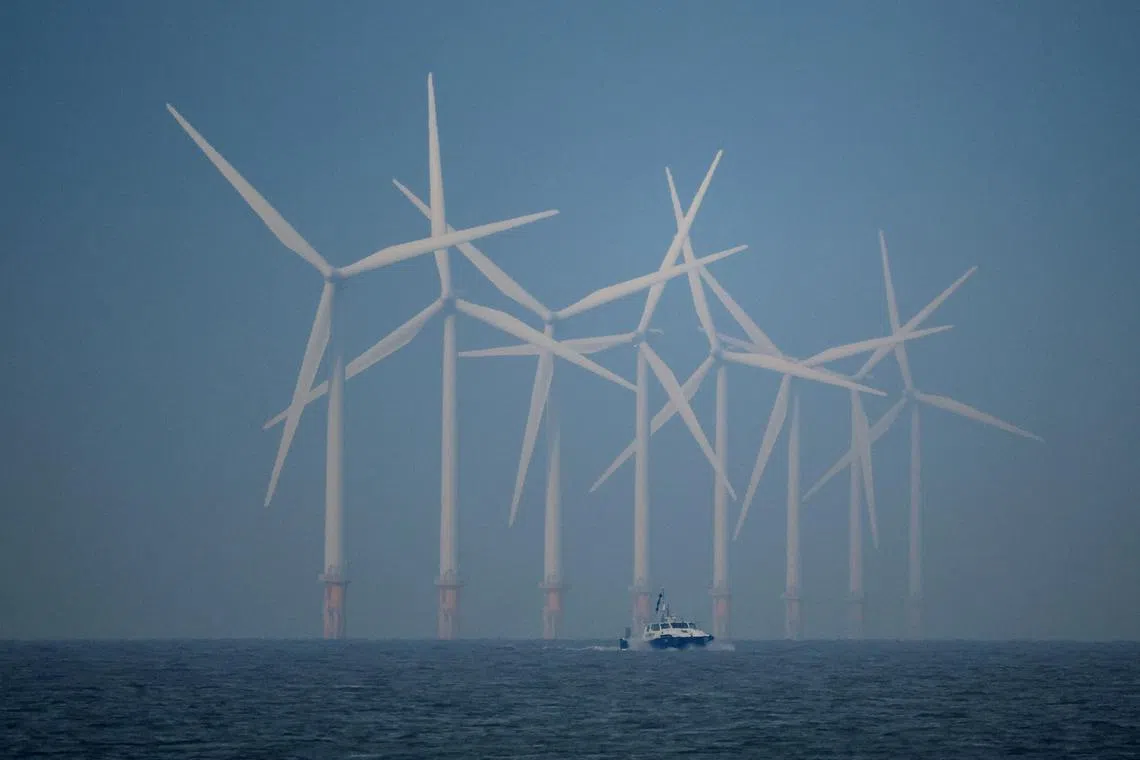Offshore wind farms send some North Sea birds fleeing: Study
Sign up now: Get ST's newsletters delivered to your inbox

The population of Red-throated loons was found to have decreased significantly in the vicinity of offshore wind turbines.
PHOTO: REUTERS
Follow topic:
BRITAIN – Red-throated loons, a type of water bird that ancient Gaels relied on to predict the weather – are so avoidant of offshore wind turbines in the North Sea that their numbers declined significantly in the immediate vicinity, a new study finds, adding to concerns about balancing the world’s push for renewable energy
The study, published on Thursday in the peer-reviewed journal Scientific Reports, investigated how the abundance of the birds changed since 14 offshore wind farms were constructed in the south-eastern waters of the North Sea.
Using data from ships, aircraft and digital aerial surveys each year during March and April, the researchers recorded a downward pattern from 2010 to 2017.
The study shows the overall population of almost 35,000 loons, primarily red-throated loons, in the observed sites fell by nearly 30 per cent after the wind farms were built. The loons shied away from all 14 wind farms, with their numbers declining by as much as 94 per cent within a 1km zone.
“This worries us substantially,” said Mr Stefan Garthe, a co-author of the paper and a marine ecology professor at Kiel University in Germany. “While we acknowledge the urgent need for renewable energy, we face the problem that wind farms hardly provide any benefit for seabirds.”
The installation of wind turbines offshore is not always bad news for marine conservation. For instance, mollusks and small fish have been shown to turn turbines into artificial reefs.
But seabirds seem to face a high risk of fatal collisions and habitat loss. Red-throated loons are unusually avoidant of human activity but other species including white-tailed eagles and skuas are also exposed to adverse effects of offshore wind development, a separate 2013 study showed.
Mr Garthe said his team was surprised that the decline even occurred at distances larger than 5km away from the wind farms. In fact, the disruption was so far-reaching that the loons’ population more than halved within a 10km zone, according to the study.
Fish-eating, migratory birds that are also known as divers, red-throated loons are not endangered but are protected under a United Nations-backed international treaty. In recent years, their numbers have been decreasing due to intensified ship traffic, oil spills and, increasingly, a changing climate that affects the distribution of fish stocks.
The researchers warn that the installation of offshore wind turbines will likely pose another blow as birds are now forced to live in a smaller feeding ground.
The migratory birds are a food source for indigenous people in Canada and traditionally played a role in weather forecasts in Scotland. The behaviour of the red-throated loon, according to Gaelic tradition, might be used to predict rain or bad weather, earning the bird the nickname “rain goose”.
The North Sea is in the centre of a dilemma facing global policymakers. It is home to a wide array of marine life but it is also key to Europe achieving its goal of ditching planet-warming fossil fuels.
Last year, Germany, Belgium, Denmark and the Netherlands pledged to install a total of 150 gigawatts of wind energy in the North Sea by 2050.
To keep the world’s temperature rise below 1.5 deg C, almost 90 per cent of the world’s electricity will have to come from solar panels, wind turbines and other renewable energy sources, up from about 30 per cent now, the International Energy Agency estimates.
But adding more renewable energy projects can also come with an ecological cost. Hydroelectric dams disrupt migration routes for fish.
Concentrating solar thermal plants, a form of solar energy that harnesses heat from sunlight to produce electricity, risks incinerating insects.
Wind turbines pose a threat to whales, including critically endangered right whales, although the extent to which they are implicated in recent whale deaths along the United States East Coast is unclear.
“Although renewable energies will be needed to provide a large share of our energy demands in the future, it is necessary to minimise the costs in terms of less-adaptable species, to avoid amplifying the biodiversity crisis,” the researchers noted in their paper.
The authors call for the creation of more marine protected areas to safeguard vulnerable species such as red-throated loons. “This would provide a kind of compromise between renewable energy installation and prevention of biodiversity loss,” Mr Garthe said. BLOOMBERG

